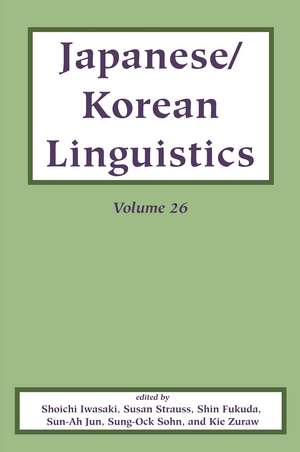Japanese/Korean Linguistics, Volume 26: Japanese/Korean Linguistics, cartea 26
Editat de Shoichi Iwasaki, Susan Strauss, Shin Fukuda, Sun-Ah Junen Limba Engleză Paperback – 28 sep 2020
Preț: 204.70 lei
Preț vechi: 231.82 lei
-12% Nou
Puncte Express: 307
Preț estimativ în valută:
39.18€ • 40.79$ • 33.11£
39.18€ • 40.79$ • 33.11£
Carte indisponibilă temporar
Doresc să fiu notificat când acest titlu va fi disponibil:
Se trimite...
Preluare comenzi: 021 569.72.76
Specificații
ISBN-13: 9781684000654
ISBN-10: 1684000653
Pagini: 435
Dimensiuni: 152 x 229 x 25 mm
Greutate: 0.54 kg
Editura: Center for the Study of Language and Inf
Colecția Center for the Study of Language and Inf
Seria Japanese/Korean Linguistics
ISBN-10: 1684000653
Pagini: 435
Dimensiuni: 152 x 229 x 25 mm
Greutate: 0.54 kg
Editura: Center for the Study of Language and Inf
Colecția Center for the Study of Language and Inf
Seria Japanese/Korean Linguistics
Notă biografică
Shoichi Iwasaki is Professor i the Department of Asian Languages and Cultures at the University of California, Los Angeles
Cuprins
PART I: Phonetics and Phonology Default Word Prosody and its Effects on Morphology HARUO KUBOZONO (KEYNOTE SPEAKER) Epistemic Bias Interacts with Prosodic Pattern in South Gyeongsang Korean HYUN KYUNG HWANG Register-Specific Phonology in Core Grammar: Expressive Strategies in Korean Aegyo HAYEUN JANG Orthography Dependence of Korean Speakers on Adaptation of English Unstressed Syllable HYOJU KIM Tokyo Japanese Speakers’ Multimodal Perception in Voicing Contrast HYUNSOON KIM, TAKEKI KAMIYAMA AND PIERRE HALLÉ Compound Truncation in Japanese: 2+2, 2+1, or Discontiguous 2+2? YU TANAKA The Effects of Era and Perceptual Distinctiveness on Japanese Loanword Adaptation WENTING TANG AND JIE ZHANG PART II: Syntax and Semantics Determiner Phrase: How Nominals are Built and How Variant Orders Are Derived MIN-JOO KIM (KEYNOTE SPEAKER) Negation in Korean Time Measure Constructions PAOLA CEPEDA AND JIWON YUN Transitive Nominals in Japanese and the Syntax of Predication SHIN FUKUDA A Temporal Restriction in the Semantics of Evidence YUTO HIRAYAMA Double Relative Clauses in Korean EUN HEE KIM, SEA HEE CHOI, JUNGHWAN MAENG, HA RAM KIM, NAYOUNG KIM, NAKYUNG YOON AND JAMES YOON The English Rise-Fall-Rise Contour and the Japanese Contrastive Particle Wa: A Uniform Account DAVID YOSHIKAZU OSHIMA How to (Not) Say to ‘Say’ HIROAKI SAITO Two Types of Sino-Korean Verb Formation: How do Verbs Determine Their Adicity? CHANGGUK YIM PART III: Experimental Studies What Children See is Not What They Get YOSHIKI FUJIWARA AND HIROYUKI SHIMADA Embedded Topicalization in Korean Factive Clauses and Islands: Experimental Approach EUNSUN JOU Directness of Causation and Morphosyntactic Complexity of Constructions: Japanese and Korean Cases KAZUHIRO KAWACHI, SANG-HEE PARK AND ERIKA BELLINGHAM Honorific Mismatch in Korean Gapping: An Experimental Study CHAE-EUN LEE, DUK-HO JUNG AND JEONG-SEOK KIM Experimental Study of Inter-Language and Inter-Generational Intelligibility: Methodology and Case Studies of Ryukyuan Languages MASAHIRO YAMADA, YUKINORI TAKUBO, SHOICHI IWASAKI, CELIK KENAN, SOICHIRO HARADA, NOBUKO KIBE, TYLER LAU, NATSUKO NAKAGAWA, YUTO NIINAGA, TOMOYO OTSUKI, MANAMI SATO, RIHITO SHIRATA, GIJS VAN DER LUBBE AND AKIKO YOKOYAMA PART IV: Functional Approach Genitals in Japanese: Eroticism, Cuteness, and Sexist Conceptual Metaphor CAREY BENOM Korean Evidential –te, the Past Tense –ess, and the Commitment of the Speaker SEMOON HOE, YUGYEONG PARK, DONGSIK LIM AND CHUNGMIN LEE ‘I came,’ ‘I saw,’ ‘I am’: Deictic Conceptions Behind Experience Report and Disclosure KATSUNOBU IZUTSU, TAKESHI KOGUMA AND YONGTAEK KIM Subjectivity and Referent Honorific Markers in Japanese KAZUE KANNO PART V: Grammaticalization Another Type of List Buoys in Japanese Sign Language: Emergence from Gesture YUKO ASADA Grammaticalization of Korean mwusun ‘what kind of’ HYE SEUNG LEE On the Emergence of Discourse Markers of Emphasis in Korean SEONGHA RHEE From a Clause-Combining Conjunction to a Sentence-Initial Adverbial Connector in the History of Japanese: With Special Attention to totan (-ni) ‘at the moment’ REIJIROU SHIBASAKI From Manner to Pseudo-Quotation: The Grammaticalization of Korean sik (‘style, manner’) and Japanese fuu (‘wind, manner’) KIM YEWON AND KAORU HORIE PART VI: Conversation Analysis Imperatives in Ordinary Talk: Turn Designs, Embodied actions, and Sequences in Korean Interaction MARY SHIN KIM (KEYNOTE SPEAKER) Pragmatic Uses of the Korean Sentence Ender -Na/-(u)Nka SEUNGGON JEONG AND EUN YOUNG BAE Preference Organization and Sequence-Responding Actions HEE JU Poster Session Abstracts








